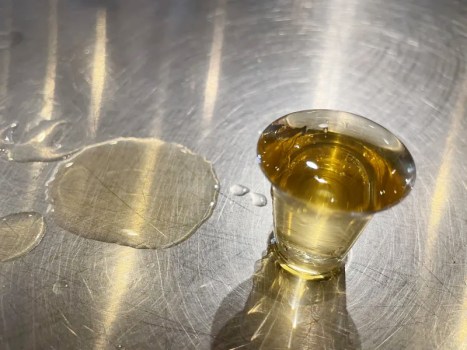Moonshine: From no business to big business; Once illegal, Appalchia’s “likker” is now government-sanctioned booze
Published 9:07 am Friday, March 10, 2023
|
Getting your Trinity Audio player ready...
|
BY KEITH ROYSDON
For The Daily Yonder
Moonshine has always been the stuff of Appalachian legends. For some, it was a way of life.
And it’s now a big business. Stills have been brought down from the hills, figuratively speaking, and set up along the Parkway in Pigeon Forge and Gatlinburg, Tennessee.
But not all the stills are out of the hills. Is moonshine – the unregulated, untaxed ‘shine – still made by liquor renegades in hollers throughout the land?
“Bwahaha!” Sky Sutton laughed in an interview for this article. “Of course it is!”
Sky Sutton is the daughter of Marvin “Popcorn” Sutton, one of the best-known practitioners in the modern era of moonshine making. He’s the subject of an exhibit at the Museum of Appalachia, north of Knoxville, and his history has been told in articles, books – including one by his daughter – and documentaries.
His legendary status was cemented on March 16, 2009, when the 62-year-old killed himself by carbon monoxide poisoning a few days before he was to report to federal prison following his conviction on alcohol-related and other charges.
Sutton didn’t invent moonshine, of course. The history of the product of corn distilled into powerful liquor is long and colorful and goes back beyond society’s image of a hillbilly tending a copper still in a thick stand of trees.
Revenuers Not Welcome
Not far from the town of Jamestown, Tennessee, there’s an all-but-gone wide spot in the road named No Business. My parents, who grew up in Jamestown, said the town’s name was meant to send a message to Revenue agents looking for moonshine stills:
“Revenuers have no business coming around here.”
The town – which had been founded in the late 1700s and was once home to 300 people but doesn’t really exist anymore – is in reality probably named after No Business Creek, although what inspired the name of the creek is uncertain. A few articles written about No Business, whose last few buildings collapsed and were overtaken by woods sometime in the 1970s, suggest the name of the town probably referred to white settlers who had “no business” in the area.
A National Park Service post about No Business doesn’t attempt to explain the name, nor acknowledge any moonshining connection. But the moonshine theory resonates.
That’s because, as anybody familiar with the history of moonshine knows, revenue agents looking for unlicensed stills are a big part of the legend.
And, incredibly, the legend is still a reality, to some extent.
‘Took the Paint Off’
Stroll into Ole Smoky Moonshine in Gatlinburg or Pigeon Forge and you’ll see a long wall filled with a rainbow-colored array of moonshine for sale. Bottles line the walls, at least of the Pigeon Forge store, and not only include jars of every flavor variation you can think of but also jars stuffed with pineapple chunks, cherries or chunks of pineapple, soaking in moonshine. And you can buy the strong original ‘shine.
Moonshine used to be considered homemade liquor, notoriously strong, sold in jugs or canning jars. It was produced and sold without benefit of regulations, inspections or – most offensive of all, at least to many in the government – taxes paid on sales.
Was it really strong?
“My dad has a story about drinking it out of a Mason jar, then putting it down on the hood of a car and it took the paint off,” said Ginna Winfree Burrell, a Nashville attorney with expertise in Tennessee liquor law. Before her current law practice, she was staff attorney, assistant director, and interim director of the Tennessee Alcoholic Beverage Commission.
Chemically, moonshine is not always stronger than Everclear, a spirit made from grain. Everclear brand of grain alcohol is sold in strengths up to 190 proof, which means that the contents of the bottle are 95% alcohol. Online sources say moonshine can have an alcohol content of up to 150 proof, or 75%. Budweiser, by comparison, is five percent alcohol by volume.
Moonshine can be and has been made anywhere for hundreds of years, but it is the stuff of legend because the ‘shine of Tennessee and other southern states has been popularized by stories, movies, and TV. One season of the TV series “Justified” followed the exploits of the Bennett family, whose matriarch Mags dispatches an enemy with poison she put in her apple pie ‘shine.
The Encyclopedia of Appalachia book notes that in the 1700s, immigrants from the British Isles and Northern Ireland imported their knowledge of distilling using copper pots and condensing coils, “introducing a craft and eventually illegal enterprise that became a central element of the region’s identity.”
The ’shine makers made use of corn grown by Native Americans in their recipes as they had used barley when they made Irish and Scotch whiskeys. The book notes that the many streams in the Appalachian states also gave them plenty of clean water. George Washington built a still at Dogue Creek in Virginia and hired a Scottish distiller to run it.
Moonshine had been made in the Americas for centuries but the word itself wasn’t popular until the 1860s after the government levied taxes on whiskey production to help pay off Civil War debt. Moonshine at first referred to the nighttime movement of whiskey to avoid paying taxes but eventually became synonymous with the liquor itself.
The Encyclopedia notes that the production of moonshine boomed during the Prohibition years, 1920 to 1933. Three locales became known as moonshine capitols: Wilkes County in North Carolina, Dawson County in Georgia, and Cocke County in Tennessee. Transporting moonshine from Chattanooga to Knoxville to Asheville to Atlanta meant transporting the corn whiskey in fast vehicles, as shown in the 1958 film “Thunder Road,” starring Robert Mitchum as one of the moonshine drivers and Gene Barry as one of the pursuing U.S. Treasury agents, or “Revenuers.” Some of those daring road warriors became the first NASCAR drivers, the book notes.
It was in Cocke County, Tennessee, as well as Maggie Valley, North Carolina, where Popcorn Sutton made his ‘shine.
Popcorn Sutton and His ‘Likker’
In the collection of the Museum of Appalachia, there’s one of Popcorn Sutton’s stills. The “free-spirited and colorful (figure) … was regarded as a legendary moonshiner. Although he lived in Parrotsville, Tennessee, Popcorn was known to tell people that he lived in North Carolina in case someone was interested in turning him over to the ‘revenuers’ for making illegal whiskey,” the museum notes.
“Sutton was a pop culture figure, often interviewed and quoted, and he wrote “Me and My Likker,” his autobiographical tale of moonshining, co-authored by Ernestine E. Upchurch. Of Scots-Irish heritage, Sutton said he came from a long line of moonshiners. He had been arrested in the 1970s and 1980s for selling untaxed liquor and gun-related offenses and was convicted in 1985. Another conviction followed in 2007. In 2008, he pleaded guilty to illegally distilling spirits and possession of a firearm as a felon.”
The 62-year-old’s death on March 16, 2009, from carbon monoxide poisoning, was attributed by some as a way out of an 18-month term in prison.
After his death, a group of partners including country star Hank Williams Jr. produced and marketed Popcorn Sutton’s Tennessee White Whiskey. The venture had the blessing of Pam Sutton, Popcorn Sutton’s widow, but ran afoul of the owners of Jack Daniel’s distillery, which manufactured whiskey in dry Lynchburg, Tennessee. Jack Daniel’s sued over the design of the
Popcorn Sutton bottle and the lawsuit was eventually settled and Popcorn Sutton “small batch whiskey” is available through retailers.
The beginning of the marketing of the well-known moonshiner came just as Tennessee was making changes to its liquor laws, particularly in relation to the production, sales, and service of liquor and what’s branded as moonshine.
With manufacturing overseen by the state, the federal government overseeing taxes and local municipalities deciding through referendums if they want to be dry or wet, Tennessee liquor law is “a patchwork of laws from 1939 on … we just keep adding to the quilt, a patch here and there,” said liquor attorney Burrell.
In the wake of changes in liquor laws, Ole Smoky Moonshine Distillery entered the scene. In 2010, the distillery became the first federally licensed distillery in Eastern Tennessee. The company’s original distillery opened in 2010 in Gatlinburg and the Pigeon Forge location opened in 2014.
Employees behind long, bar-like counters tout bottles of the 100-proof original recipe as well as apple pie, watermelon, and a dozen other flavors. The only consumption on the premises in Pigeon Forge is of the samples of the company’s varieties, served up for $5 for nine samples along with a pitch for merchandise. Ole Smokey products are sold at liquor stores in several states.
Ole Smoky opened only about a year after Popcorn Sutton’s death. Does Burrell think the introduction of legal ‘shine was unfair following the moonshiner’s suicide following law enforcement action stemming from illegal liquor?
“Unfair? I don’t think so,” the attorney said. “At the time it was just enforcing the laws on the books. That’s their job.”
Asked what she thought of the change of the legal status of moonshine on the heels of her father’s death, Sky Sutton said, “I think that over-the-counter moonshine and mountain-made likker are two different beasts. The over-the-counter kind now has its place on the shelves of liquor stores. The mountain-made kind is still elusive, mysterious, and much stronger.”
Sutton said she believes government-approved moonshine, like state lotteries, won’t crush more illicit activities.
“I think the government and the black market – booze, betting, etc. – are both as old as dirt and will both stay around for a long time,” she said.
Keith Roysdon writes news and pop culture articles for online sites. He’s a Tennessee resident after having worked in Indiana newspapers for 40 years, beginning in high school. His fourth co-authored true crime book will be published by The History Press in 2023. His crime novel “Seven Angels” won the 2021 Hugh Holton Award for Best Unpublished Novel from Mystery Writers of America Midwest.







